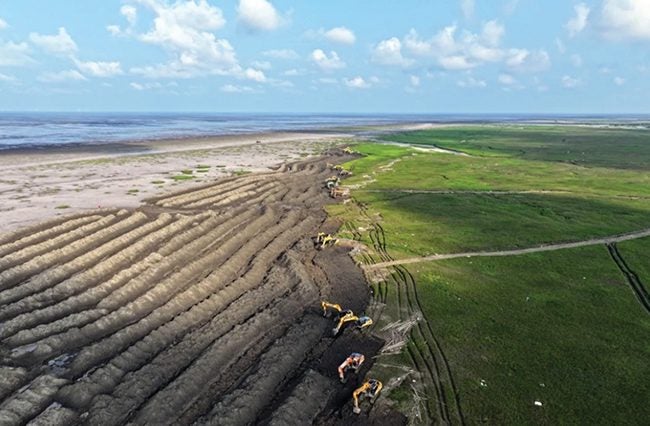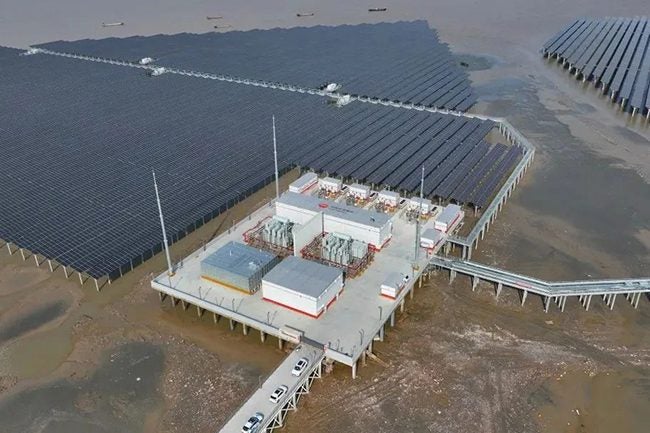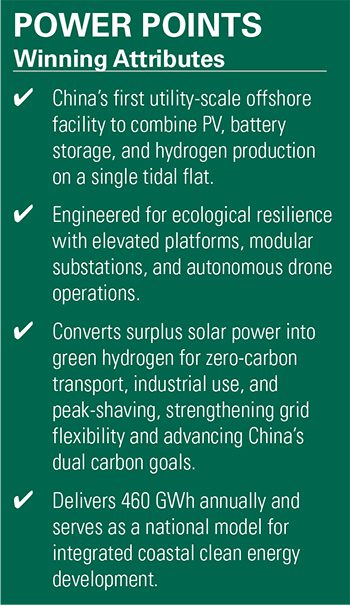 |
Built on degraded tidal flats in China’s Jiangsu Province, CHN Energy’s Rudong project combines 400 MW of offshore photovoltaic generation, grid-scale battery storage, and green hydrogen production with ecological restoration and fully automated operations.
Rudong County, located on the Yellow Sea coast of eastern China’s Jiangsu Province, is a region defined by fertile tidal flats, a rich agricultural heritage, and an extensive 66-mile-long coastline. The region’s landscape is a patchwork of verdant fields and productive wetlands, bolstered by its subtropical monsoon climate, abundant rainfall, and flat terrain. But over the past four decades, Rudong’s tidal flats faced an escalating ecological crisis, driven by both human development and biological invasion.
Since the 1950s, nearly 40,000 hectares of land (98,842 acres) have been reclaimed in Rudong alone, transforming mudflats into farmland, aquaculture ponds, and industrial zones. The relentless transformation has been compounded by reduced sediment supply from major rivers like the Yangtze, owing to upstream damming and sand mining. It has led to drastic coastal erosion, narrowing and steepening of the tidal flats, and a loss of their natural capacity to buffer storm surges and sustain biodiversity.
At the same time, the region has grappled with a rapid invasion of Spartina alterniflora—or smooth cordgrass—a fast-growing, salt-tolerant grass. Originally introduced to China’s coast in 1979 to stabilize shorelines and reclaim land, Spartina quickly outcompeted native marsh plants, morphing open mudflats into dense monocultures, further altering their sediment dynamics and posing a new threat to the region’s rich biodiversity.
By the 2000s, Rudong’s shrinking tidal flats and the Spartina alterniflora invasion prompted urgent calls for restoration. In 2019, China launched its “dual carbon” strategy, targeting peak emissions by 2030 and carbon neutrality by 2060, followed by a 2020 master plan that prioritized coastal wetland recovery. A 2021–2025 Renewable Energy Plan then sought to elevate hybrid systems—solar, storage, and hydrogen—as national priorities.
Meanwhile, that same year, Rudong County signed a strategic partnership with state-owned energy conglomerate CHN Energy, the Beijing Low Carbon Clean Energy Research Institute, and Jiangsu Zhongtian Technology to develop a hydrogen energy industry chain, including production, equipment manufacturing, and refueling infrastructure. A key aim was to transform Rudong into a “green energy demonstration city,” to leverage its strategic location in the central area of the Yangtze River Delta and its proximity to ports and major industries, including petrochemicals, chemicals, and transportation.
 |
|
1. The Rudong Offshore Integrated Photovoltaic (PV)-Hydrogen-Storage Project, developed by CHN Energy’s Guohua Energy Investment Co. Ltd., is China’s first offshore facility to combine solar power, battery storage, and green hydrogen production. Built on 287 hectares (709 acres) of reclaimed tidal flats in Jiangsu Province, the 400-MW plant achieved full grid connection in May 2025. Courtesy: CHN Energy |
As part of the country’s third batch of “Desert, Gobi, and Rocky Areas Mega Wind and Solar Base Projects”—a national initiative to pilot and then accelerate renewable deployment in underutilized or ecologically fragile regions—CHN Energy’s Guohua Energy Investment Co. Ltd. advanced the Rudong Offshore Integrated Photovoltaic (PV)-Hydrogen-Storage Project on degraded tidal flats in Jiangsu Province. The project—one of the first and largest of its kind in the world—envisioned a bold integration of 400 MW of offshore PV, a 60-MW/120-MWh battery storage system, a 220-kV shore-based substation, and a 1,500 normal cubic meters per hour (Nm 3 /h) hydrogen production and refueling station. The Rudong project (Figure 1) achieved full capacity grid connection in May 2025 and is set to generate 468 GWh annually with annual utilization of about 1,170 hours.
A Marvel of Engineering
Getting it built, however, required feats of engineering. The Rudong facility is built on a 287-hectare (709-acre) site that poses unique obstacles: Along with daily tidal fluctuations of 3 to 4 meters, the facility’s heavy infrastructure would be vulnerable to corrosive salt spray and soft sediment. The Rudong project’s engineers set out to pioneer solutions that would balance its energy generation, accomplish its intended ecological restoration, and keep it resilient to coastal hazards. At the same time, Guohua Investment was determined to execute the project with “high quality, high speed, and low cost.”
To avoid disrupting the fragile ecosystem, CHN Energy’s design team developed an elevated permeable concrete platform system to support the offshore solar array. According to state-owned infrastructure development company China Power Construction, the structure, supported by reinforced concrete piles driven into the seabed, allows natural tidal flows while providing a stable base for the facility’s solar arrays and equipment. It notes that the platform’s open-grid design also reduced concrete use compared to conventional slabs and enabled marine organisms to thrive beneath the panels.
 |
|
2. Rudong’s elevated, permeable concrete platform supports a modular onshore booster station at the heart of a 400-MW tidal flat solar array. The pioneering design minimizes ecological disruption while enabling resilient energy generation in a coastal environment. Courtesy: CHN Energy |
The Rudong facility, notably, also showcased China’s first compact, modular, prefabricated cabin-type onshore booster station (Figure 2). A radical departure from traditional designs, the substation was prefabricated off-site and assembled in just 17 days. The double-layer stacked configuration slashed the substation’s footprint by 50% while incorporating typhoon-resistant anchoring that withstood 2024’s Category 3 Typhoon Bebinca, China Power Construction said. The design also improved cable layout by placing cables beneath the platform rather than in traditional cable trenches.
To maximize energy yield in Rudong’s fog-prone, high-reflectivity tidal flat environment while withstanding harsh coastal conditions, CHN Energy selected N-type monocrystalline bifacial double-glass modules. The facility’s 697,866 solar panel modules and their 112,281 pile foundations—installed in only 4 months—feature an innovative backside optical design and high-transparency glass that delivered a 2.29% power generation gain in the tidal zone.
In another remarkable innovation, project developers implemented a “river-sea-land” integrated transport method to lay a continuous 3.5-kilometer (km) submarine cable. China Power Construction notes that the cable was first shipped down the Yangtze River, transferred by sea to a coastal port, and then delivered along an 8-km seawall using approximately 1,800 four-wheeled platform carts. The carts, outfitted with ultra-wide tires, exerted less ground pressure than a human footstep to enable safe transport across fragile tidal flats without damaging adjacent clam and laver aquaculture zones. The method also significantly reduced construction costs and minimized ecological disturbance.
But perhaps the project’s most profound innovation lies in its “PV + Spartina control” methodology, which uses elevated photovoltaic (PV) panels to shade 80% of the tidal flat surface, creating conditions in which native halophytes can outcompete invasive Spartina alterniflora. At the same time, the cleared mudflats have created better growth conditions for marine organisms, contributing to the recovery and sustainable development of local fishery resources.
Hydrogen Horizons
 The Rudong project’s 1,500 Nm3/h hydrogen plant—powered entirely by surplus solar energy—is a core demonstration of China’s push for integrated green hydrogen infrastructure. Developed by CHN Energy’s Beijing Low Carbon Clean Energy Research Institute, the facility uses modular alkaline electrolyzers that allow flexible hydrogen production across variable solar generation conditions. According to CHN Energy, each electrolyzer produces 500 Nm3/h and uses nickel-based catalysts to reduce rare metal dependence, enhancing scalability for coastal deployment. Hydrogen is reportedly compressed to 35 MegaPascal (MPa) using corrosion-resistant diaphragm systems from Jiangsu Zhongtian Technology and stored in six 18-meter Type IV composite tanks with a total capacity of 3,600 kg.
The Rudong project’s 1,500 Nm3/h hydrogen plant—powered entirely by surplus solar energy—is a core demonstration of China’s push for integrated green hydrogen infrastructure. Developed by CHN Energy’s Beijing Low Carbon Clean Energy Research Institute, the facility uses modular alkaline electrolyzers that allow flexible hydrogen production across variable solar generation conditions. According to CHN Energy, each electrolyzer produces 500 Nm3/h and uses nickel-based catalysts to reduce rare metal dependence, enhancing scalability for coastal deployment. Hydrogen is reportedly compressed to 35 MegaPascal (MPa) using corrosion-resistant diaphragm systems from Jiangsu Zhongtian Technology and stored in six 18-meter Type IV composite tanks with a total capacity of 3,600 kg.
The gas feeds a dual-use hydrogen refueling station—described as Jiangsu’s first—to serve both fuel cell vehicles and hydrogen-powered vessels. Additional infrastructure, such as a green ammonia pilot plant, a 2-MW solid oxide fuel cell (SOFC), and a hydrogen-powered aquaculture logistics network, have been floated as forward-looking applications though not confirmed in official project documentation.
Commissioning Triumph
CHN Energy notes that Phase 1 of the Rudong project—comprising 200 MW of PV capacity and 30 MW/60 MWh of energy storage—was successfully connected to the grid on Dec. 31, 2024. The facility reached full 400 MW capacity on April 29, 2025, and the hydrogen production system went online by mid-May. The project was reportedly completed three months ahead of schedule owing to prefabricated construction methods, including modular cabin-type substations and platform-mounted equipment.
For now, Rudong is also being recognized as a technical benchmark for integrated clean energy development. While detailed operational data has not yet been publicly disclosed, CHN Energy highlights the site’s incorporation of intelligent inspection, PV fault detection, and advanced energy management systems. According to CHN Energy and PowerChina, the project employs “drone and 5G-based smart operation systems” to reduce onsite personnel needs and enhance monitoring capabilities in the challenging tidal flat environment. Engineering breakthroughs, such as the project’s steel sheet pile cofferdams, four-wheeled platform carts, and intermodal “river-sea-land” cable transport, were pivotal in meeting the aggressive timeline.
Valued at ¥5.3 billion ($730 million), the Rudong complex is already being studied as a model for replication across additional coastal provinces. “The Rudong project is poised to strengthen regional energy infrastructure by improving grid stability and peak-shaving capabilities,” CHN Energy said. “It will also contribute to energy structure optimization and sustainable development in Rudong County and surrounding areas.”
—Sonal Patel is a POWER senior associate editor (@sonalcpatel, @POWERmagazine).




